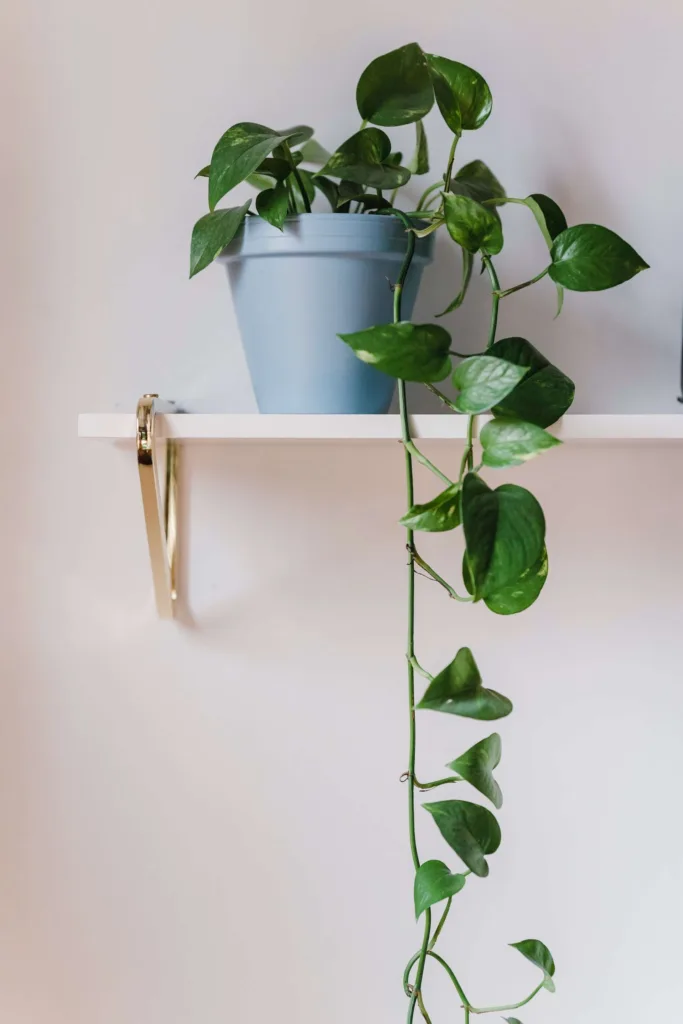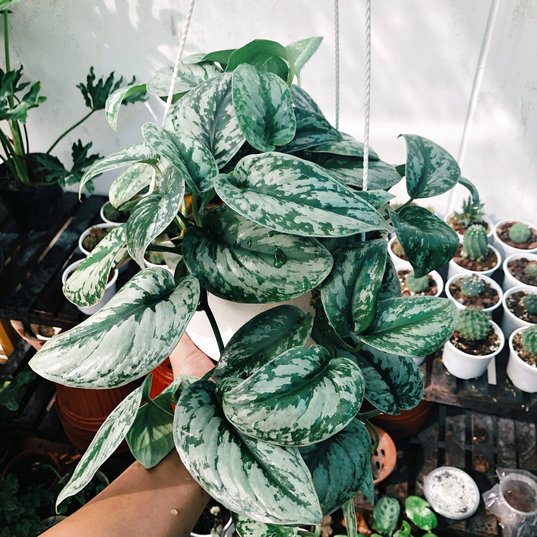Scindapsus Pictus, commonly known as satin pothos or silver vine, is a popular and attractive houseplant admired for its attractive leaves.
Belonging to the Araceae family, this tropical vine is native to Southeast Asia and is appreciated for its low-maintenance nature and air-purifying properties.
| Characteristic | Description |
|---|---|
| Common Names | Satin Pothos, Silver Pothos |
| Scientific Name | Scindapsus pictus |
| Type | Tropical trailing vine, epiphytic |
| Foliage | Heart-shaped leaves with a velvety texture, silver markings on dark green leaves |
| Growth Habit | Trailing or climbing; suitable for hanging baskets or as a climbing plant with support |
| Light Requirements | Prefers bright, indirect light; can tolerate lower light conditions (avoid direct sunlight) |
| Watering | Allow the top inch of soil to dry out between waterings; avoid overwatering to prevent root rot |
| Soil | Well-draining potting mix with organic matter |
| Temperature | Thrives in average to warm temperatures; protect from drafts and cold temperatures |
| Humidity | Prefers higher humidity levels but can adapt to average household humidity |
| Maintenance | Pruning helps maintain a bushy and compact appearance; occasional fertilization during the growing season |
| Toxicity | Considered mildly toxic if ingested; keep out of reach of pets and small children |
| Propagation | Can be propagated through stem cuttings placed in water or soil |
| Common Issues | Susceptible to overwatering, root rot, and pests like spider mites; good drainage and regular inspection are essential |
Best Tips for Potting Mix
When it comes to potting Scindapsus Pictus, it’s crucial to choose a well-draining soil mix. A blend of equal parts peat moss, perlite, and potting soil provides an ideal medium for this tropical plant.
The peat moss retains moisture, while the perlite promotes drainage, preventing the roots from becoming waterlogged.
This mix offers the perfect balance of water retention and aeration that Scindapsus Pictus requires.
Planting Your Scindapsus Pictus
Once you have selected the appropriate potting mix, it’s time to plant your Scindapsus Pictus. Here’s a step-by-step guide to ensure a successful planting process:
Choose a pot with drainage holes: Opt for a pot with drainage holes at the bottom to prevent water from accumulating and causing root rot.
Add a layer of small stones: Before adding the potting mix, place a layer of small stones or broken pieces of terracotta at the bottom of the pot. This will enhance drainage and prevent the soil from clogging the drainage holes.
Fill the pot with potting mix: Fill the pot with the prepared potting mix, leaving enough space at the top to accommodate the plant and water.
Gently remove the plant from its nursery pot: Carefully remove the Scindapsus Pictus from its current nursery pot, taking care not to damage the roots.
Position the plant in the pot: Place the plant in the center of the pot and add more potting mix around it, ensuring the roots are covered.
Press the soil lightly: Use your fingers or a small tool to press the soil lightly around the plant, providing stability.
Water thoroughly: After planting, water the Scindapsus Pictus thoroughly to help settle the soil and hydrate the roots.

Optimal Light Conditions for Scindapsus Pictus
Scindapsus Pictus thrives in bright, indirect light. It is best to place it near a north or east-facing window to provide it with the right amount of light without exposing it to direct sunlight. Direct sunlight can scorch the leaves and cause them to bleach or burn.
Adjusting to Low Light Conditions
If you have a room with low light conditions, don’t worry! Scindapsus Pictus is known for its adaptability and can survive in lower light conditions.
However, the growth may slow down, and the variegation on the leaves may become less pronounced. To ensure the plant stays healthy, rotate it every few weeks to ensure all sides receive some light.
Supplemental Grow Lights
In situations where natural light is limited, you can also consider supplementing with artificial grow lights.
LED grow lights are an excellent option as they provide the required spectrum of light without generating excessive heat.
Watering Frequency and Techniques
Watering is a crucial aspect of scindapsus pictus care. The key is to find the right balance between keeping the soil moist and avoiding waterlogging, as overwatering can lead to root rot. Here are some tips to help you water your Scindapsus Pictus effectively:
Check the soil moisture: Before watering, check the moisture level of the soil by inserting your finger about an inch deep. If it feels dry, it’s time to water.
Water thoroughly: When watering, ensure that you thoroughly saturate the soil until water drains out from the bottom. This helps remove any accumulated salts and ensures proper hydration.
Allow the topsoil to dry out: After watering, allow the topsoil to dry out before watering again. Over time, you’ll develop a watering routine based on the specific requirements of your plant and environment.
Avoid overwatering: As mentioned earlier, overwatering can harm your scindapsus pictus. Always err on the side of underwatering rather than overwatering. The plant prefers drying out between waterings rather than staying constantly moist.
Consider using a moisture meter: If you find it difficult to gauge soil moisture levels accurately, you can invest in a moisture meter.
This tool provides precise readings and helps you determine the optimal time to water your Scindapsus Pictus.
Humidity and Temperature Requirements
Scindapsus Pictus appreciates moderate to high humidity levels, which mimic its natural tropical habitat. To increase humidity levels around the plant, you can place a humidifier nearby or use a pebble tray.
Fill a tray with water and place a layer of pebbles in it. Set the pot on the pebbles, ensuring that the water level is below the pot’s bottom. As the water evaporates, it increases the humidity around the plant.
When it comes to temperature, scindapsus pictus thrives in average household temperatures ranging from 65 to 85 degrees Fahrenheit (18 to 29 degrees Celsius).
Avoid exposing the plant to sudden temperature fluctuations, cold drafts, or excessively low temperatures, as these can stress the plant and affect its growth.
Fertilizing Your Scindapsus Pictus
To ensure healthy growth and vibrant foliage, it’s important to fertilize your Scindapsus Pictus regularly.
During the growing season, which typically spans from spring to early fall, you can feed the plant with a balanced, water-soluble fertilizer diluted to half strength.
Apply the fertilizer once every two to four weeks, following the manufacturer’s instructions. During the dormant winter months, you can reduce or stop fertilization, as the plant’s growth slows down.
Always remember to water the plant lightly before applying fertilizer to avoid burning the roots.

Pruning and Propagation
Pruning is an essential part of scindapsus pictus care and helps keep the plant compact and bushy.
Regular pruning encourages new growth, removes any dead or yellowing leaves, and enhances the plant’s overall appearance. You can use clean, sharp shears to trim any leggy or overgrown vines as desired.
If you wish to propagate your Scindapsus Pictus, it’s relatively easy to do so through stem cuttings. Simply take a healthy vine, cut it just below a node, and place it in water or a well-draining potting mix.
Keep the cutting in a warm, humid environment until it develops roots. Once the roots are established, you can transplant it into a new pot.
Types of Scindapsus Pictus
- Scindapsus pictus ‘Argyraeus’ (Satin Pothos):
- Features silver-gray markings on dark green leaves. It is one of the most common varieties.
- Scindapsus pictus ‘Exotica’ (Silver Pothos ‘Exotica’):
- Similar to the ‘Argyraeus,’ but with more pronounced and irregular silver markings on the leaves.
- Scindapsus pictus ‘Silver Lady’ (Silver Lady Pothos):
- A compact cultivar with smaller leaves and a more delicate growth habit. The silver markings are prominent.
- Scindapsus pictus ‘Silvery Ann’ (Silvery Ann Pothos):
- Known for its highly variegated leaves with prominent silver patterns and irregular shapes.
- Scindapsus pictus ‘Silver Splash’ (Silver Splash Pothos):
- Features large silver markings on the leaves, creating a striking contrast with the dark green background.
- Scindapsus pictus ‘Silver Satin’ (Silver Satin Pothos):
- Similar to the ‘Argyraeus,’ with silver markings but often exhibits a more satin-like sheen on the leaves.
- Scindapsus pictus ‘Trebi’ (Trebi Pothos):
- Recognized for its unique variegation pattern, with silver spots and streaks arranged in a mosaic-like fashion.
Pests and Diseases: – Satin Pothos is generally resistant to pests and diseases. However, like many houseplants, it may occasionally encounter issues such as spider mites or scale insects. Regular inspection and proper care can help prevent and address these issues.
Conclusion
Scindapsus Pictus is a stunning houseplant that adds a touch of elegance to any indoor space. With its beautiful silver variegated leaves and easy-care nature, it’s an ideal choice for both beginners and experienced plant enthusiasts.
By following the planting and care tips outlined in this guide, you can ensure your Scindapsus Pictus thrives, creating a lush and green oasis in your home.
So go ahead, bring home this captivating plant, and embark on a rewarding journey of nurturing and enjoying its beauty!
People Also Ask
Is Scindapsus pictus poisonous?
- Scindapsus pictus is considered mildly toxic if ingested. Keep it out of reach of pets and small children.
Is Scindapsus indoor or outdoor plant?
- Scindapsus pictus is primarily an indoor plant. It is often grown as a houseplant or in containers indoors. In tropical climates, it may be grown outdoors in shaded or protected areas.
Is Scindapsus pictus safe for pets?
- While considered mildly toxic, it can irritate if ingested. It’s advisable to keep Scindapsus pictus out of reach of pets and monitor them to prevent nibbling on the plant.

